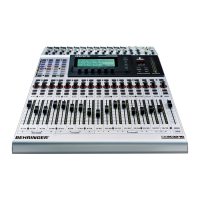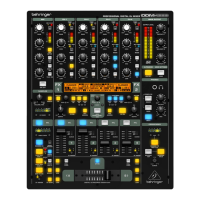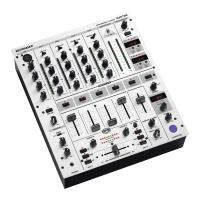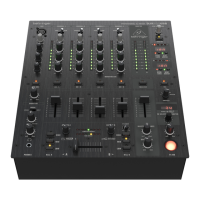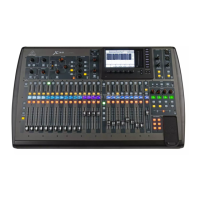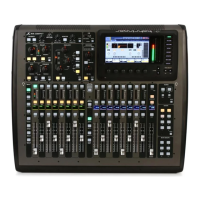28
5.2.13 Stereo Phaser
A phaser is a phase shifter with LFO modulated phase shift.
The signal is also fed back. The resulting phase shift is called
comb filter effect. When phasing is applied to an audio signal, the
signal becomes “thicker” in texture and more lively in character,
an effect that is often used for guitar sounds and keyboard
pads, and had its heyday in the 70’s, when phasers were standard
devices for electric pianos.
Fig. 5.14: Parameters of Stereo Phaser algorithm
Stages (2 to 10)
Stages determines the number of phase-shift stages.
Speed (0.1 to 10 Hz)
This parameter controls the LFO frequency and thus the
modulation speed.
Depth (0 to 100%)
This parameter governs the modulation depth, i. e. the amplitude
of the modulating oscillation.
Feedback (-99 to +99%)
The Feedback parameter feeds some of the output signal back
to the input.
Stereo Phase (0 to 180°)
This parameter determines the phase shift of the modulating
waveform between the left and right channels.
5.2.14 Pitch Shifter
This effect varies the pitch of the input signal. Small values
(cents) produce a subtle detune effect, but the pitch can also be
shifted in semitones. The input signal can be transposed up and
down by one octave. Use this effect to create intervals and
harmonies or simply to widen single voices. Heavy detuning of
vocals by several semitones upward gives you the well-known
Mickey Mouse effect.
Fig. 5.15: Parameters of Pitch Shifter algorithm
Semitone (-12 to +12)
The Semitone parameter allows you to detune the input signal
up and down in semitone steps. The maximum interval is one
octave or 12 semitones.
Cents (-50 to +50)
Use this parameter to fine-tune the detune effect.
Delay (0 to 800 ms)
The Delay parameter controls the delay time of the effect signal.
Feedback (0 to 80%)
This parameter feeds the effect signal back to the effect input.
Higher values lead to distinctive pitch-shifter effects greatly
exceeding the 1-octave interval.
5.2.15 Delay
The Delay algorithm allows you to delay the input signal by as
much as 1.8 s. Use it to create rhythmic patterns.
Fig. 5.16: Parameters of Delay algorithm
Delay (0 to 1,800 ms)
This parameter controls the delay time for the effect channel.
Feedback (0 to 99%)
Feedback controls the number of repetitions.
Feedback-HP (20 Hz to 10 kHz)
This parameter controls the cutoff frequency of a high-pass
filter acting on the feedback signal.
Feedback-LP (100 Hz to 20 kHz)
Feedback-LP adjusts the cutoff frequency of a low-pass filter
acting on the feedback signal.
5.2.16 Flanger
This algorithm provides a mono version of the Stereo Flanger
algorithm (see chapter 5.2.12).
Fig. 5.17: Parameters of Flanger algorithm
Wave (Sine/Tri)
The Wave parameter determines the shape of the modulating
waveform (sine or triangle).
Feedback (-99 to +99%)
Feedback controls the portion of the effect signal that is fed
back to the effect block. Positive values increase, negative value
reduce the volume of the repetitions.
LFO Speed (0.05 to 20 Hz)
The LFO Speed parameter controls the speed (frequency) of
the modulating signal.
Feedback-LP (200 Hz to 20 kHz)
Feedback-LP adjusts the cutoff frequency of a low-pass filter
acting on the feedback signal.
Mod Depth (0 to 100%)
This parameter determines the modulation depth, i. e. the
amplitude of the modulating signal.
Mod Delay (0.5 to 50 ms)
Mod Delay controls the delay of the modulated signal.
5.2.17 Chorus
This algorithm provides a mono version of the Stereo Chorus
algorithm (see chapter 5.2.11).
Fig. 5.18: Parameters of Chorus algorithm
Wave (Sine/Tri)
The Wave parameter determines the shape of the modulating
waveform (sine or triangle).
5. EFFECTS PROCESSORS

